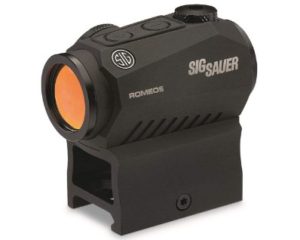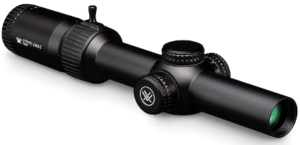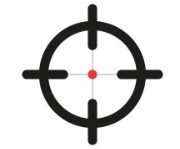Choosing the right equipment for your firearm is important if you want precise and accurate shots. In this red dot vs scope comparison, we will share the pros and cons of these sights to help you make a well-informed purchase.
Before you proceed, it is advisable to define your shooting requirements. This will help you find an optic for your shooting needs. However, we will provide additional guidance if you are still stuck.
Riflescopes are popular because they are built for nearly every shooting scenario. Before buying any scope, it is important to check the magnification and the objective lens size.
We recommend buying a scope with a high magnification and a large objective lens. This is because you can use it for different shooting applications like hunting or target shooting.
On the other hand, red dots are suitable for engaging close to medium-range targets. They are designed for faced-paced situations, making them suitable for self-defense and hunting. You can also use it to hone your target shooting skills.
Let us have a closer look at red dot sights and scopes.
What is a Red Dot?
 A red dot is a simple optic used to engage close-range targets. They are non-magnifying optics that use a simple red dot as the reticle to improve precision and accuracy. However, the dot can be green in color.
A red dot is a simple optic used to engage close-range targets. They are non-magnifying optics that use a simple red dot as the reticle to improve precision and accuracy. However, the dot can be green in color.
Red dot sights have a compact and lightweight design, which makes them ideal for fast-paced shooting applications, like tactical shooting. They are also very easy to use, making them suitable for beginners who want to hone their precision and accuracy skills.
It is worth mentioning that red dots are 1x optics. This means they do not have a built-in magnification for engaging long-range targets. However, you can pair a red dot with a red dot magnifier to improve clarity.
Red dots are made from superior-quality materials that withstand heavy recoil and impact. Therefore, you can mount your red dot on a rifle, handgun, or shotgun for more precise aiming.
The other exceptional feature of red dots is their unlimited eye relief. This means that you can use both eyes when aiming at a target.
The only downside of red dots is that they are battery dependent. We recommend carrying additional batteries if you plan to use your firearm for a long time.
Let us look at the pros and cons of red dots.
Pros
- Red dots are designed for shooting applications that require fast target acquisition.
- They have a wide field of view, which helps to improve accuracy.
- They are made from durable materials and have a shock-resistant and waterproof design.
- They are compatible with many firearms.
- They have a compact and low-profile design.
- They are more affordable compared to high-end scopes.
Cons
- Red dots are battery dependent.
- They have limited magnification.
- The red dot is washed out in bright light conditions.
What is a Scope?
 A scope is an optic mostly used on rifles to improve precision and accuracy at varying distances. They provide a magnification and a reticle to aid in engaging targets.
A scope is an optic mostly used on rifles to improve precision and accuracy at varying distances. They provide a magnification and a reticle to aid in engaging targets.
Scopes provide a magnified image of the target, which makes them suitable for engaging long-range targets. You can also adjust for windage and elevation to compensate for wind and bullet drop effects. This helps to eliminate any guesswork in your shooting applications.
It is worth mentioning that scopes have different magnification levels and reticle patterns. They offer improved accuracy and precision compared to red dot sights. This is why they are used for hunting, competitive, and tactical shooting.
Scopes have a fixed or variable magnification. Fixed scopes have a fixed magnification, while variable scopes allow you to change the magnification. The min difference is versatility, as a variable scope will enable you to engage targets from different distances.
Before selecting any scope, it is important to check the lens clarity and objective lens size. The lenses should have proprietary coatings to enhance clarity. You should also check the field of view.
Let us look at the pros and cons.
Pros
- Scopes have a variable magnification, allowing you to engage targets at varying distances.
- They can be adjusted for different shooting conditions to eliminate guesswork.
- They have coated lenses to improve clarity.
- They are designed to be shockproof, waterproof, and fog proof.
- They can withstand heavy recoil and impact.
- They help to eliminate parallax.
Cons
- Scopes are heavy, which might affect stability.
- It is hard to mount them on a rifle.
- Scopes are complex and difficult to adjust.
Frequently Asked Questions on Red Dot Vs Scope
- Do riflescopes require batteries?
Riflescopes with illuminated reticles require battery power. It’s important to choose a scope with a long battery life or consider a backup battery when using a scope in the field. This is why it is always advisable to check the product information before making any purchase.
- What range is a red dot good for?
Red dots are used for close to medium-range shooting, about 50-100 yards. However, the range depends on the specific red dot sight you buy.
- What is the difference between a red dot and a riflescope?
A red dot sight projects a single red dot onto a lens, allowing the shooter to align the dot with the target quickly. On the other hand, a riflescope magnifies the image of the target. Scopes have crosshairs or different reticles to aid in aiming.
- Which is better for close-range shooting, a red dot or a scope?
Red dot sights are typically better for close-range shooting due to their quick acquisition of the target and wide field of view. While they can be used at close range, scopes can be more difficult to use quickly due to the need to adjust the magnification and find the target in the crosshairs.
- Can I use a scope for tactical situations?
Yes, you can use a scope for tactical situations where longer-range precision is important. However, they are not as quick as red dot sights in close-range engagements.
Conclusion
In conclusion, red dots and scopes are designed for different shooting applications. Therefore, your choice will depend on your specific shooting requirements.
For close-range shooting, we recommend red dots. They are very easy to use and are ideal for fast-paced shooting scenarios. This is why they are used for tactical shooting or self-defense.
Riflescopes are suitable for engaging targets at varying distances. They offer greater accuracy and versatility, which makes it easy to hit long-range targets.
Finding an optic that fits your budget and intended use is also important. Also, consider factors like clarity, magnification, and ease of use.
We hope this post helped you learn more about red dots and scopes. You can also check Red Dot Vs Scope at 100 Yards.

